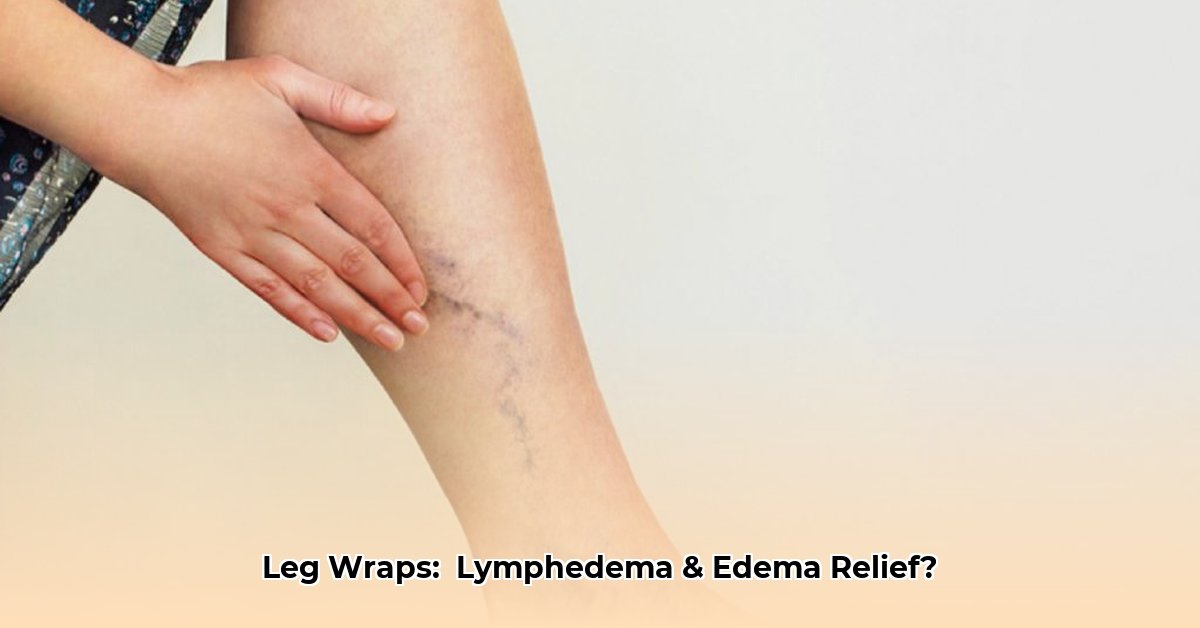Dealing with swollen legs or arms? Lymphedema and edema can be uncomfortable, but compression wraps can offer significant relief. This comprehensive guide will walk you through everything you need to know about using them – from understanding the conditions to choosing the right type of wrap, applying it correctly, and maintaining it for long-term use. We’ll cover the basics of how they work, explain the benefits over compression stockings, and discuss navigating Medicare coverage under the Lymphedema Treatment Act (LTA). Whether you’re managing swelling personally or supporting a loved one, this guide aims to make lymphedema and edema management more manageable and informed.
Leg Wraps: Your Comprehensive Guide to Lymphedema and Edema Relief
Do you know the critical factors in correctly choosing and using lymphedema wraps for optimal relief?
Experiencing swollen legs can be distressing. Many people experience swelling due to lymphedema or edema. These conditions involve fluid accumulation, causing discomfort and potential health complications. Carefully chosen and applied leg wraps, also known as compression wraps, can be crucial for managing these conditions. This guide provides an in-depth look at how they work, how to choose the appropriate wraps, and how to use them effectively.
Understanding Lymphedema and Edema: Unraveling the Swelling
Did you know that lymphedema requires specialized care, and understanding its specific needs is key to effective management?
Let’s clarify the basics. Edema is a general term referring to swelling caused by fluid retention in body tissues. While it can occur anywhere, leg swelling is common. Lymphedema is a specific type of edema resulting from lymphatic system impairment, where the body’s drainage system malfunctions. This leads to fluid accumulating in the limbs, frequently the legs and feet. While both conditions cause swelling, lymphedema necessitates more specialized and targeted care.
Leg wraps provide a practical approach to managing both lymphedema and edema. By applying controlled and graduated pressure, they assist in moving excess fluid back into circulation, reducing swelling, and improving comfort. Many individuals find that leg wraps offer more precise and customizable compression compared to compression stockings.
Types of Leg Wraps: Navigating the Options
Beyond elastic bandages, what are the diverse materials and designs available in leg wraps, and how do they cater to specific needs?
A wide array of leg wraps exists, each offering unique features and benefits. Selecting the appropriate wrap is like choosing the right tool for a specific task. Let’s explore the available options:
- Targeted Compression Areas: Wraps are specifically designed for different areas, such as the thigh, calf, ankle, foot, and even toes. This targeted approach allows for precise support where it’s needed most. For example, a calf wrap provides focused compression compared to a full-leg wrap.
- Material Composition: Wraps are made from a range of materials, including stretchy elastic bandages, soft cotton blends, and advanced high-tech fabrics. Some prioritize breathability, while others emphasize durability. For those with sensitive skin, gentle, non-irritating materials are essential. Options also include those with antimicrobial properties.
- Fastening Mechanisms: Velcro closures are common due to their adjustability and ease of use. Other options include hooks and loops, adjustable straps, zippers and even self-adhesive materials. Experimenting with different mechanisms helps determine the most manageable and comfortable option.
- Compression Levels: Compression wraps are available in varying compression strengths, typically measured in millimeters of mercury (mmHg). Common levels include 20-30 mmHg and 30-40 mmHg. A healthcare provider should help determine the appropriate compression level based on the severity of the condition.
- Specialty Wraps: Some wraps are designed with specific features, such as those for nighttime use, those with cooling gels, and those designed to be worn under clothing.
Choosing Your Leg Wraps: A Step-by-Step Guide
Before choosing leg wraps, are you aware that consulting with a healthcare professional ensures safety and avoids potential complications?
Selecting the right leg wrap is crucial for effective treatment. Consulting with a healthcare professional is highly recommended. They can assess individual needs and recommend the most suitable option. However, here’s a step-by-step guide to help you through the process:
- Assess Your Swelling: Carefully evaluate the location, severity, and pattern of your swelling. Is it localized to your calf, affecting the entire leg, or concentrated around your ankles? Note any accompanying skin changes, discomfort, or pain.
- Consult a Healthcare Professional: Consulting a doctor, physical therapist, or lymphedema specialist is essential. They can accurately diagnose the underlying cause of your swelling and recommend the appropriate compression level, type of wrap, and application technique. Self-diagnosis and treatment can be harmful.
- Consider Comfort and Fit: A comfortable wrap is essential for consistent wear and treatment adherence. Choose materials that feel pleasant against your skin and allow for breathability to prevent moisture buildup and irritation. The wrap should fit snugly but not constrictively, ensuring it doesn’t impede circulation or cause pain.
- Evaluate Ease of Application and Adjustment: Consider your physical abilities and dexterity when choosing a wrap. Opt for a fastening mechanism that you can easily manage. Adjustable wraps are beneficial for accommodating fluctuations in swelling.
- Factor in Activity Level: Consider your daily activities and choose a wrap that provides adequate support and compression while allowing for comfortable movement. If you’re active, look for durable and breathable materials that can withstand wear and tear.
- Trial and Error: If possible, try on different types of wraps and fastening mechanisms to determine what feels most comfortable and manageable for you.
Applying and Using Leg Wraps: A Practical Guide
How can you ensure proper skin care and prevent skin breakdown when applying leg wraps?
Once you have your leg wraps, proper application is essential to maximize their benefits and prevent complications:
- Prepare Your Skin: Before application, ensure your skin is clean, dry, and free of lotions, creams, or oils. This promotes proper wrap adherence and minimizes the risk of skin irritation. Consider applying a thin layer of skin protectant if you have sensitive skin.
- Gather Supplies: Gather all necessary supplies, including the leg wrap, any additional padding or liners recommended by your healthcare provider, and fasteners.
- Position Yourself Comfortably: Sit or lie down in a comfortable position with your leg slightly elevated. This helps reduce swelling and facilitates easier wrap application.
- Start at the Ankle: Begin wrapping at the narrowest part of your ankle, just above the foot. Use a gentle, overlapping spiral pattern, working your way upwards towards your heart. Each layer should overlap the previous one by approximately 50%.
- Maintain Even Tension: Apply consistent, even tension throughout the wrapping process. Avoid pulling the wrap too tightly, as this can restrict circulation and damage the skin. The wrap should feel snug but not constricting.
- Secure the Wrap: Secure the end of the wrap with the provided fasteners, such as Velcro straps, clips, or tape. Ensure the fasteners are securely attached but not overly tight.
- Regularly Monitor Your Leg: Throughout the day, periodically check your leg for any signs of skin irritation, discomfort, or changes in swelling. If you experience any problems, such as increased pain, numbness, tingling, or discoloration, loosen or remove the wrap and contact your healthcare provider immediately.
- Nighttime Removal: Unless otherwise instructed by your healthcare provider, remove the leg wrap before going to bed to allow your skin to breathe and prevent excessive pressure.
Medicare Coverage and the Lymphedema Treatment Act (LTA): Understanding Your Benefits
Are you aware of the specific criteria for Medicare coverage of lymphedema treatment under the Lymphedema Treatment Act (LTA)?
The Lymphedema Treatment Act (LTA) has significantly expanded Medicare coverage for lymphedema treatment, including compression garments like leg wraps. This legislation aims to improve access to essential care. Understanding the LTA and associated Medicare coverage can help alleviate the financial burden of managing your condition.
To determine your eligibility for coverage and navigate the claims process, consult your doctor, therapist, or a Medicare representative. They can provide guidance and support.
Caring for Your Leg Wraps: Maximizing Longevity and Effectiveness
Did you know that proper cleaning and storage techniques significantly extend the life and effectiveness of your leg wraps?
Proper care extends the lifespan of your leg wraps and ensures their continued effectiveness:
- Cleaning: Follow the manufacturer’s instructions for washing and drying. Hand-washing is often recommended to prevent damage to the material. Avoid harsh detergents, bleach, fabric softeners, or machine drying, as they can degrade the elastic and shorten the lifespan of the wraps.
- Drying: Air-dry the wraps completely on a flat surface away from direct sunlight or heat. Avoid using a clothes dryer, as high heat can damage the elastic.
- Storage: Store your leg wraps in a cool, dry place away from direct sunlight and moisture. When not in use, roll or fold the wraps neatly to prevent them from stretching or losing their shape. Avoid storing them in a compressed or crumpled state.
- Regular Inspection: Routinely inspect your leg wraps for signs of wear and tear, such as fraying, stretching, or loss of elasticity. Replace worn or damaged wraps promptly to ensure continued effectiveness.
- Avoid Abrasive Surfaces: Protect your leg wraps from contact with rough or abrasive surfaces that can damage the fabric.
Beyond the Wraps:
- Sims 4 Mods to Make Your Game Much More Fun - December 5, 2025
- Sims 4 DLC Mods Elevate Gameplay like Free Expansion Packs - December 4, 2025
- Sims 4 Gamer Mods That Deepen Your Gameplay Experience - December 2, 2025










